We may receive a commission when you use our affiliate links. However, this does not impact our recommendations.
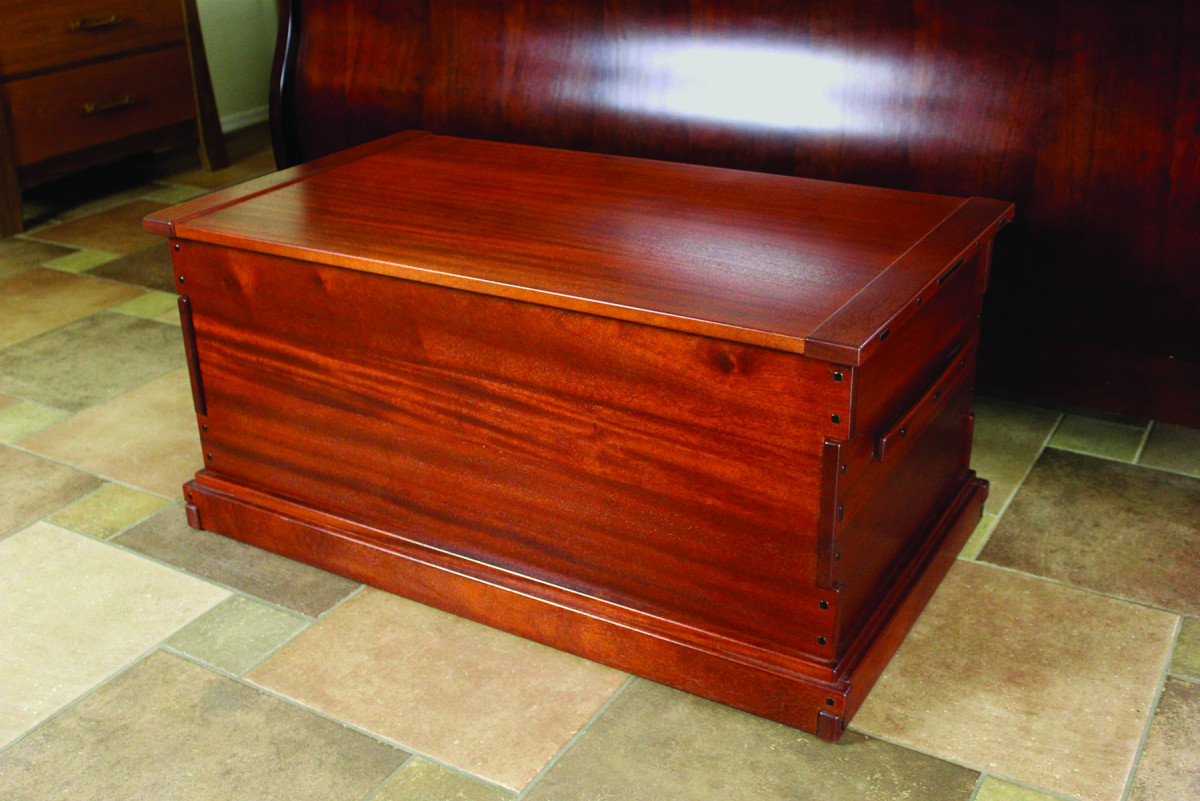
A simple approach to a sublime design.
I’ve been enamored of Greene & Greene furniture since my early days of woodworking, well before I possessed the skills to produce such a piece. Since that time, this style has become a regular part of my woodworking vocabulary, and I enjoy making reproductions and interpretations of classic Greene & Greene designs. This blanket chest is a re-imagining of an original piece designed by the Greene brothers (Charles and Henry) for the Thorsen House in Berkeley, Calif.
My wood of choice for this project was khaya, sometimes referred to as African mahogany. The original Thorsen House box was made from red oak – so don’t hesitate to use a domestic species if exotic woods don’t suit your taste or budget.
The bottom of the blanket chest is made from 3⁄4” plywood, and you can save a bunch of cash by using a domestic-veneered species instead of seeking out mahogany-faced stock. The ebony trim comes from a 2″ x 2″ x 12″ turning blank, which should provide enough ebony for several projects.
The case panels are glued up from several narrower boards. Take care to arrange your boards in such a way that they complement one another in both grain pattern and color. After cutting to length and width, the wide finger joints are milled on each end with a router and a template.
Simple Template
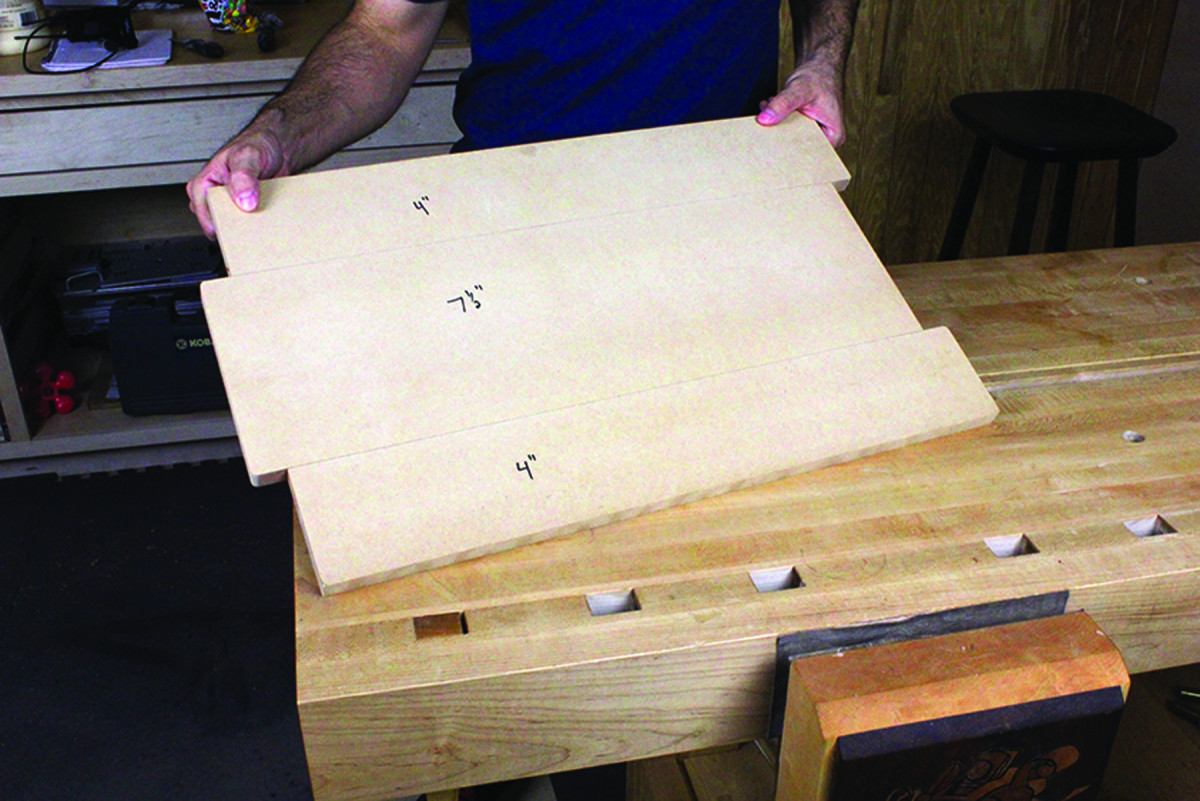
Slide it. Moving the center piece of the template and reassembling it produces mating profiles on each end of the template.
Technically you need two templates: one for the female part of the joint and one for the male. Here’s a cool way to make them both in one shot. Cut a piece of 1⁄2” or 3⁄4” sheet-good stock to approximately 16″ x 24″, making sure the corners are perfectly square. Rip the piece into two 4″-wide strips and one 71⁄2“-wide strip. With the 71⁄2” strip in the center, glue the three pieces back together after sliding the center strip out exactly 11⁄16“. Just like that, you have a two-in-one template that matches the 151⁄2” width of our case panels.
The protruding fingers of the case joints have 3⁄16” roundovers. Save yourself some extra work later by including them in the template. I use a no-frills method for making the roundovers; use a 3⁄8” drill bit as a layout guide, then use a sanding block to create the actual profile.
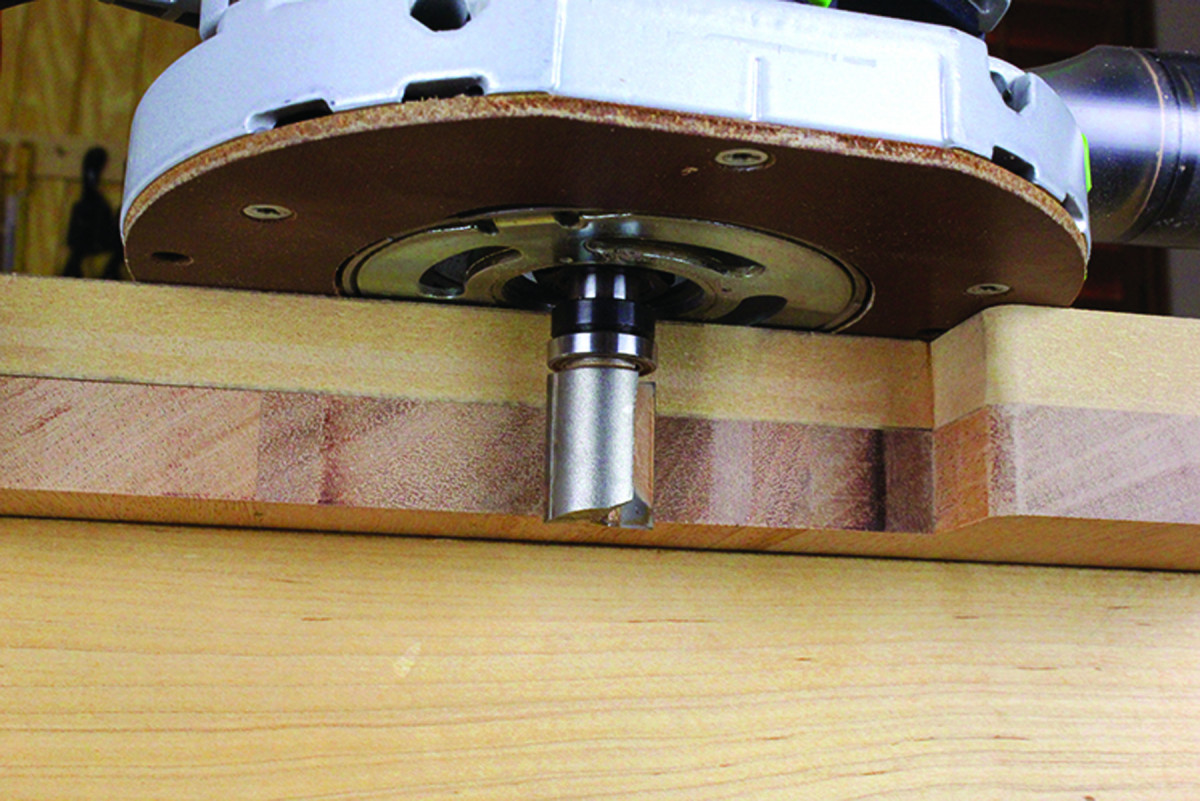
Cut close. Saw close to the pattern lines, then use a bearing-guided bit in the router to create joints that match the template.
Trace the shape of the finger joints on each chest side, then cut away the excess material. Stay at least 1⁄16” off the line. With the template clamped to the workpiece, a router outfitted with a bearing-guided pattern bit creates the finger joints on both ends of each board.
The inside corners need to be squared, then you can dry-fit the case and evaluate each joint individually. In all likelihood, the finger joints will be just a bit too tight. Use a chisel and light paring strokes to allow the fingers to nest into one another with ease.
The bottom panel of the chest rests in a groove that runs around the inside of the case. The groove is cut using a router outfitted with an edge guide and an undersized plywood bit. (Most 3⁄4” plywood is never truly 3⁄4” thick, so I use a plywood bit specifically designed for this purpose that’s 1⁄32” undersized.)
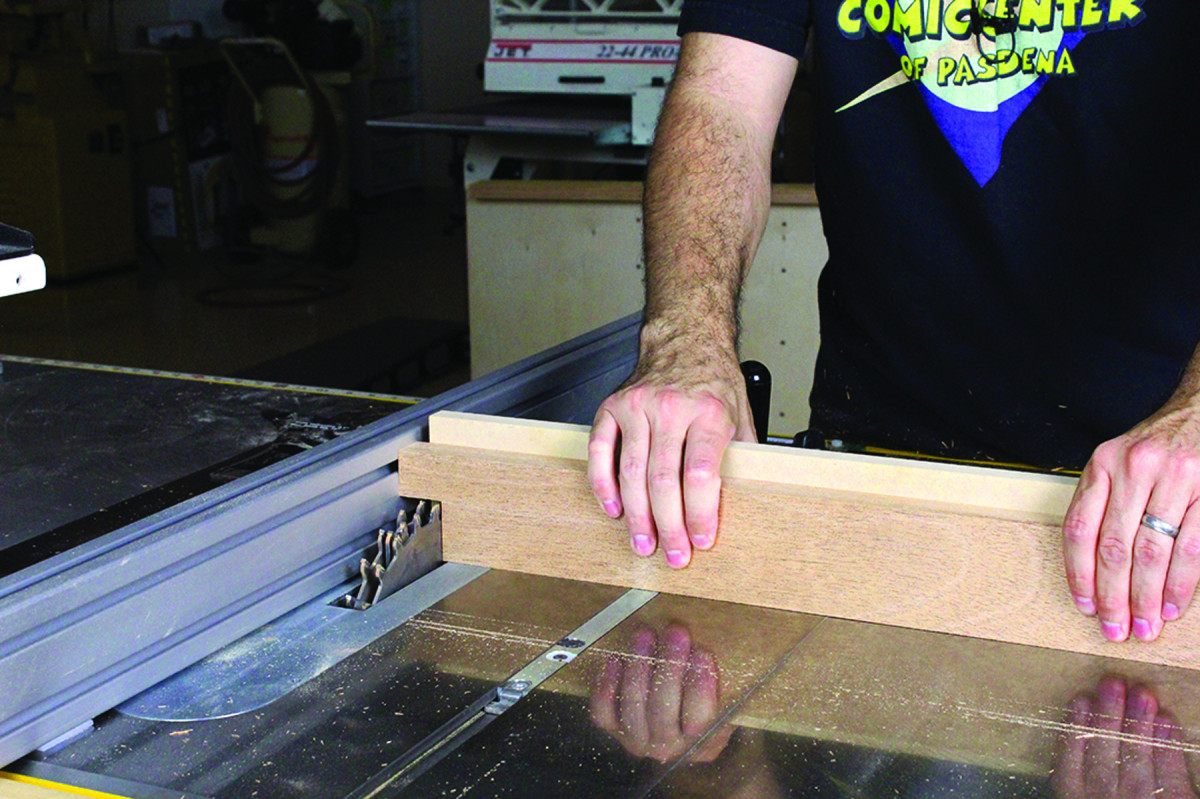
Down below. The single fingers on the base can be cut at the table saw.
The 3⁄8“-deep groove on the side panels runs from one end to the other. But on the front and back panels, a through-groove would be visible from the outside of the case. Those grooves have to stop before the end of the panel. The router bit leaves a rounded shape at the end of the groove; use a chisel to square it up.
The base for the chest consists of a deck, a finger-jointed base and 1″ x 11⁄4” cleats installed for additional support.
The deck is a large mitered frame. The 45º miters are cut at the miter saw using a stop-block for repeatability. To reinforce the miters, I installed a small loose tenon at each joint. Biscuits, dowels or pocket screws would work, too. Once the glue dries, I use a No. 80 cabinet scraper to smooth the frame and level the joints.
The base parts are milled from 5/4 stock and have finger joints at each end. There’s no need for a template here. Simply measure and mark out the joinery, then cut to the lines. It’s a good idea to test-fit the base parts as you go to ensure they fit together perfectly.
Greene & Greene-style Blanket Chest Cut List
No.ItemDimensions (inches)MaterialComments
t w l
❏ 2 Case front/back 3⁄4 x 15 1⁄2 x 41 5⁄8Khaya
❏ 2 Case ends 3⁄4 x 15 1⁄2 x 22 5⁄8 Khaya
❏ 1 Case bottom 3⁄4 x 21 1⁄4 x 40 1⁄4Plywood
❏ 2 Deck front/back 3⁄4 x 2 1⁄2 x 42 1⁄4Khaya
❏ 2 Deck ends 3⁄4 x 2 1⁄2 x 23 1⁄4Khaya
❏ 2 Base front/back 1 x 2 7⁄8 x 43 3⁄4Khaya
❏ 2 Base ends 1 x 2 7⁄8 x 24 3⁄4 Khaya Optional drawer front
❏ 2 Handles 7⁄8 x 1 3⁄8 x 14 3⁄8Khaya
❏ 1 Lid panel 3⁄4 x 24 x 39 Khaya 1⁄2 TBE*
❏ 2 Breadboard ends 15⁄16 x 2 1⁄2 x 24 3⁄8 Khaya
❏ 1 Plug material 2 x 2 x 12 Ebony
Optional Drawer Parts
❏ 2 Drawer sides 3⁄4 x 2 3⁄4 x 12 1⁄2 Khaya
❏ 1 Drawer back 3⁄4 x 2 3⁄4 x 10 1⁄8 Khaya
❏ 1 Drawer bottom 3⁄4 x 9 7⁄8 x 11 7⁄8 Poplar
❏ 1 Frame cross brace 3⁄4 x 2 7⁄8 x 23 Khaya
❏ 2 Frame sides 3⁄4 x 2 7⁄8 x 12 1⁄4Khaya
❏ 2 Drawer runners 1⁄2 x 1⁄2 x 11 7⁄8Khaya
❏ 2 Frame returns 3⁄4 x 2 7⁄8 x 6Khaya
*TBE = Tongue Both Ends
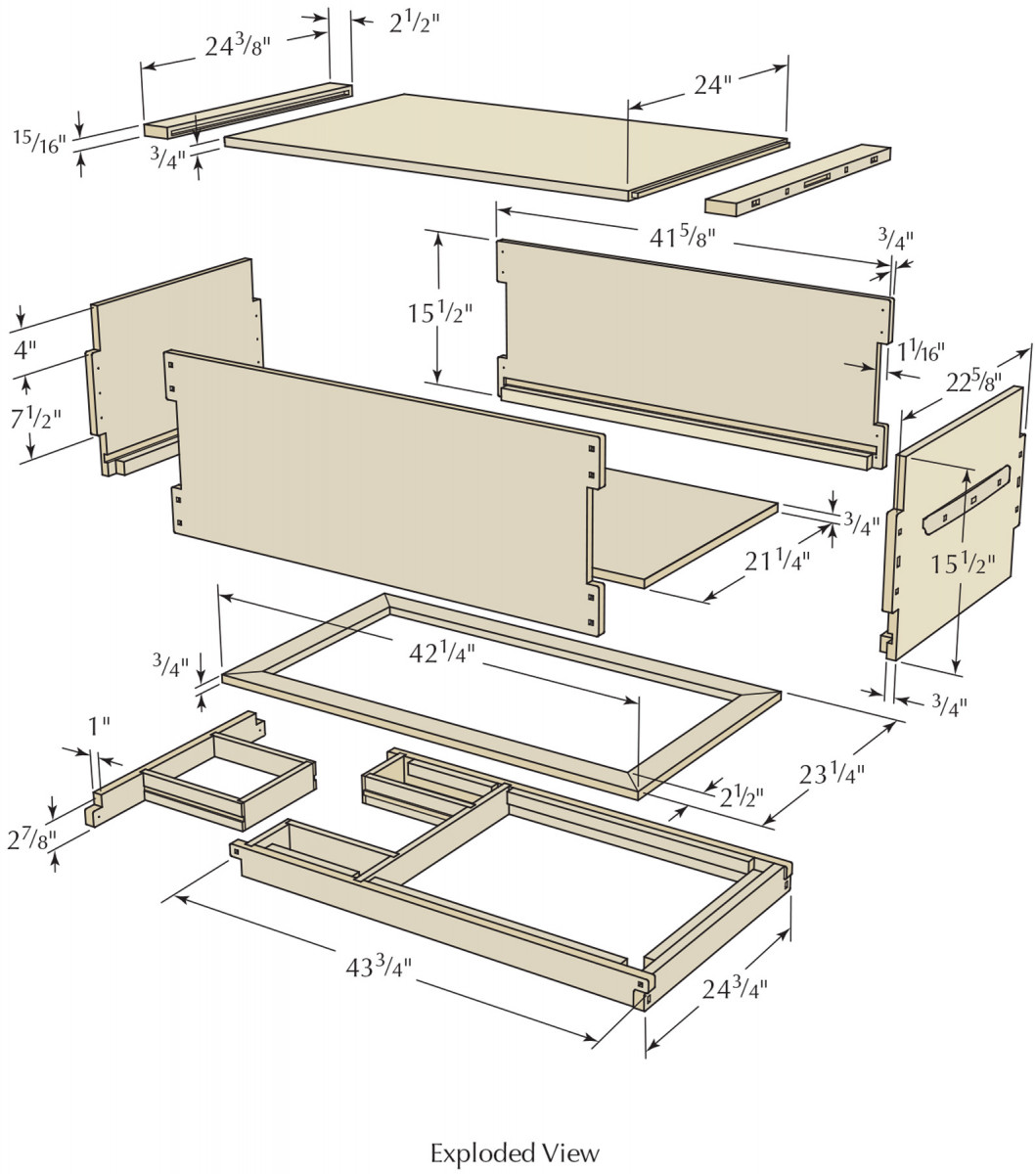
Exploded View

 I’ve Got a Secret (Drawer)
I’ve Got a Secret (Drawer)
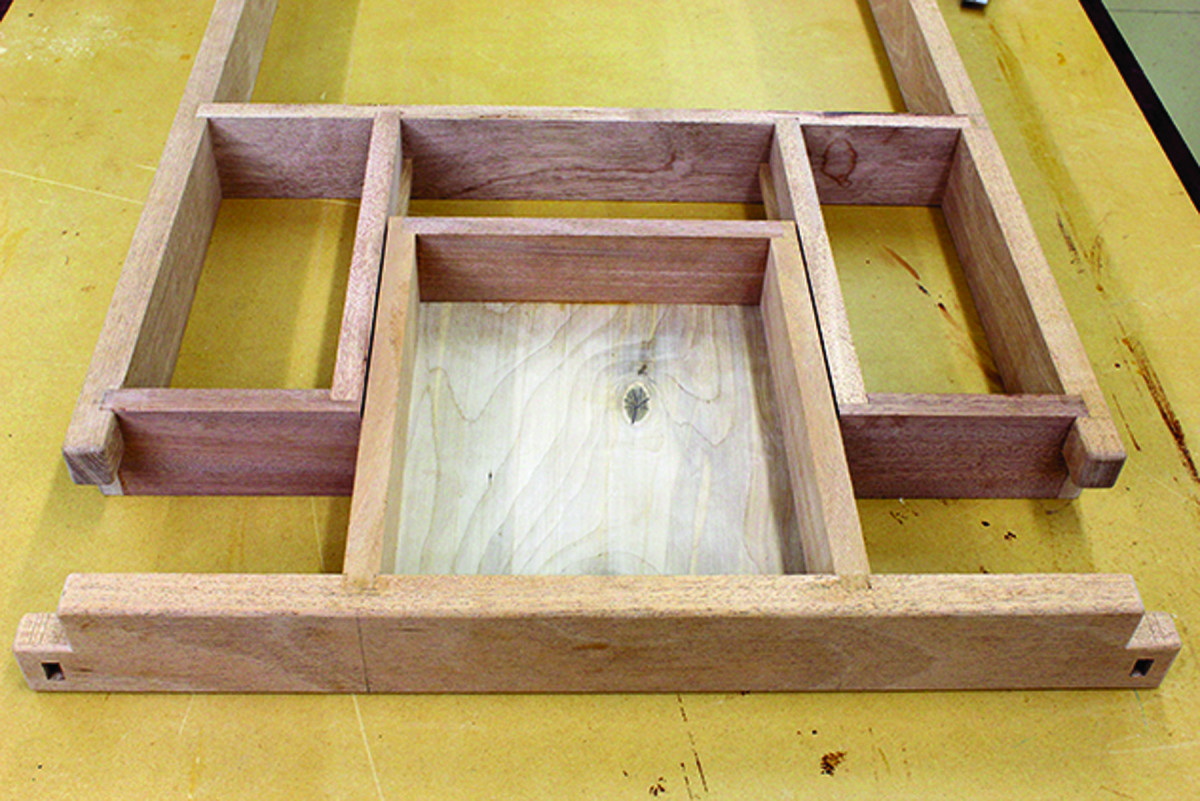
Under the end. The drawer should slide easily and the drawer front should nest snugly below the base front and back.
As designed, the base structure has a lot of dead space. The optional hidden drawer provides an opportunity to recover that space in a very cool way. The base side becomes the drawer front and a frame structure supports the drawer box. You can make the drawer as large or small as you want. Just make sure you leave room for the cleats used to attach the base to the deck.
Build the drawer and frame, double-checking the measurements against your actual workpieces. This drawer doesn’t require the level of precision we usually aspire to, so I err on the side of caution by giving the drawer some extra clearance. Unlike regular drawers, this one is at the bottom of a heavy case and it won’t be convenient to adjust should it ever bind (as you can see in the photo below).
The drawer parts attach to the base side (the drawer front) with sliding-dovetail joints, and the bottom slips into grooves cut in all four parts. The frame pieces are cut to size and fit in dado joints at the base front and back.
The drawer runners are glued into grooves cut in the sides of the drawer compartment. The drawer receives a slightly wider and deeper groove to allow about 1⁄32” extra play as it slides in and out. The key is to cut the grooves the same distance from the top of each piece (13⁄8“). This will keep the drawer flush with the top of the framework and prevent binding.
The base is assembled with glue and screws. Once dry, test-fit the drawer. If the drawer binds at all, put on your investigative cap and determine the source, then use a chisel or scraper to relieve the offending material.
Behind the Plugs
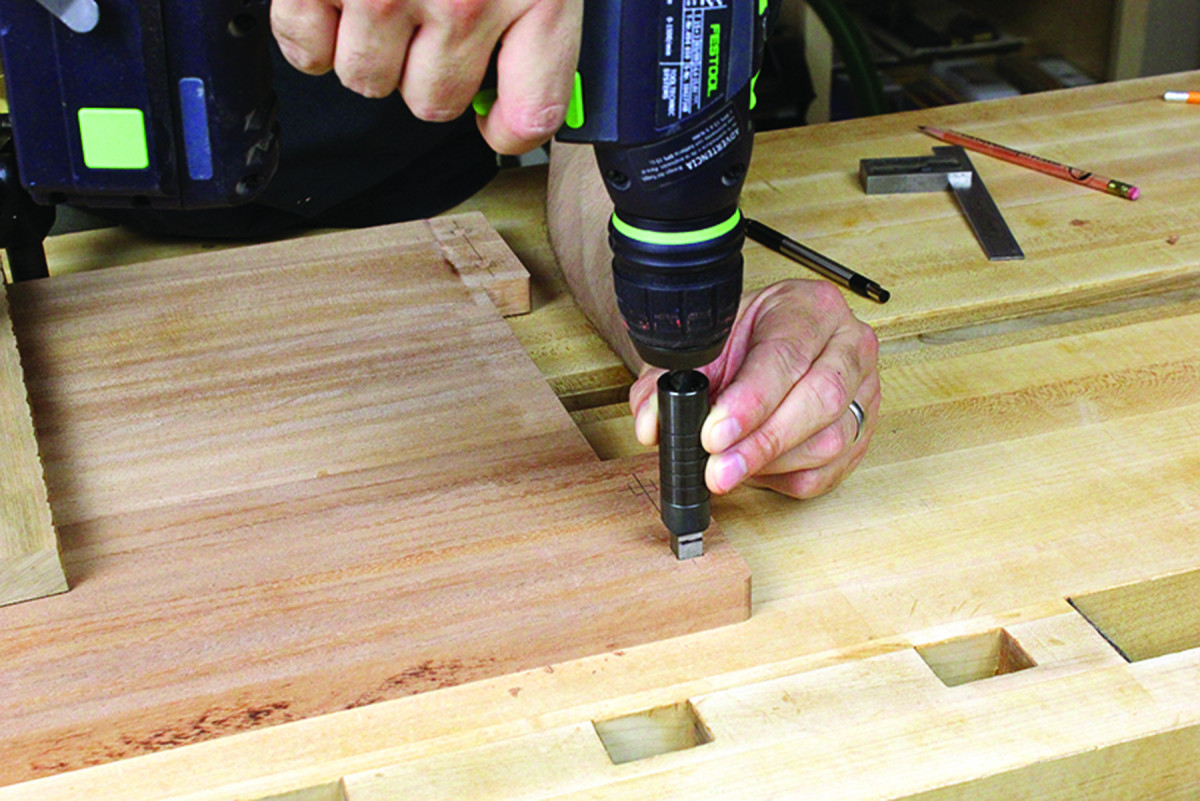
Two steps. Mortises for the ebony plugs are created by punching a square hole, then removing the waste with a drill.
The blanket chest is held together primarily with screws. Ebony plugs not only hide the screw heads, they also give the piece that classic Greene & Greene styling. The mortises for the ebony plugs need to be cut prior to assembly. Lay out the mortises as shown in the drawing (above).
I like to draw each square mortise using a plastic square template. While this may seem like overkill, it actually serves as a sanity check that helps me avoid misplaced plugs. The mortises are then cut into the case and base parts using a 3⁄8” square hole punch.
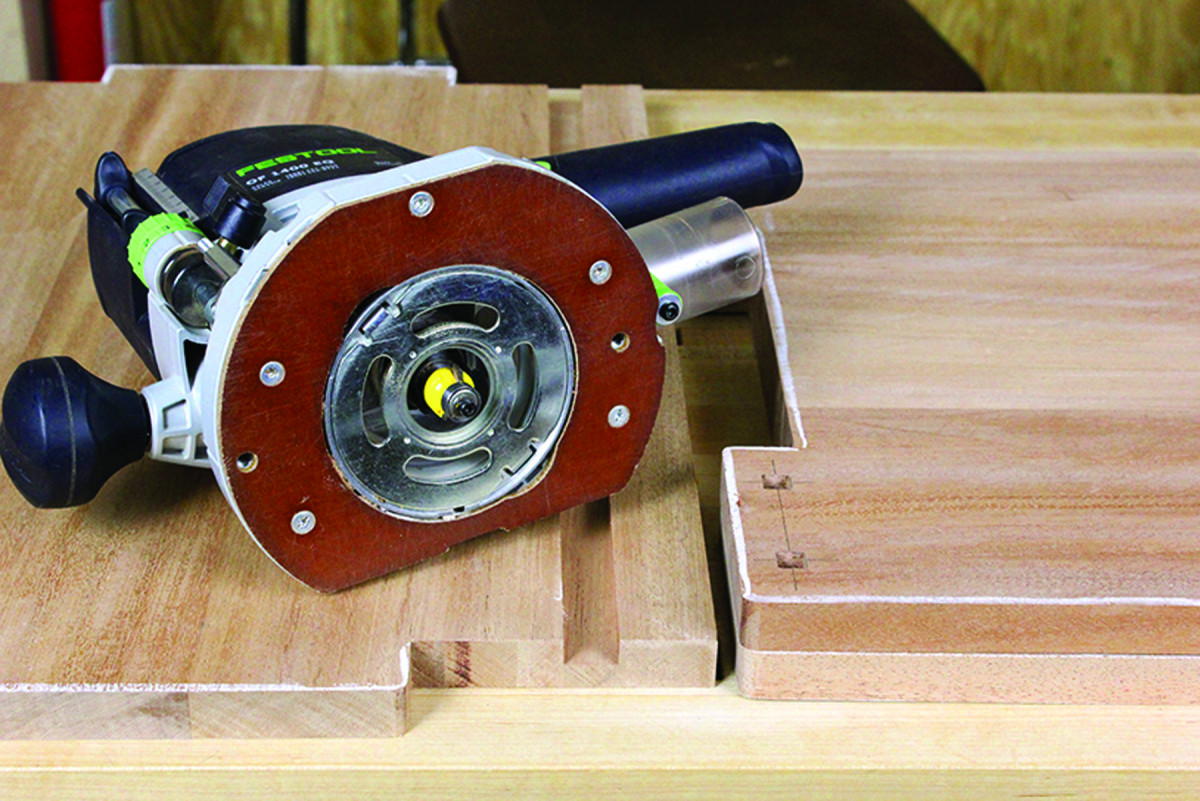
This, not that. Mark the edges to be rounded over with chalk to help prevent shaping the wrong edges.
The chest has 1⁄8” roundovers on all the long edges of the case and 3⁄16” roundovers on the breadboard ends and base. A router can do the bulk of the work but some areas need to be hit with a rasp and sandpaper to complete the profile.
The Parts Become One
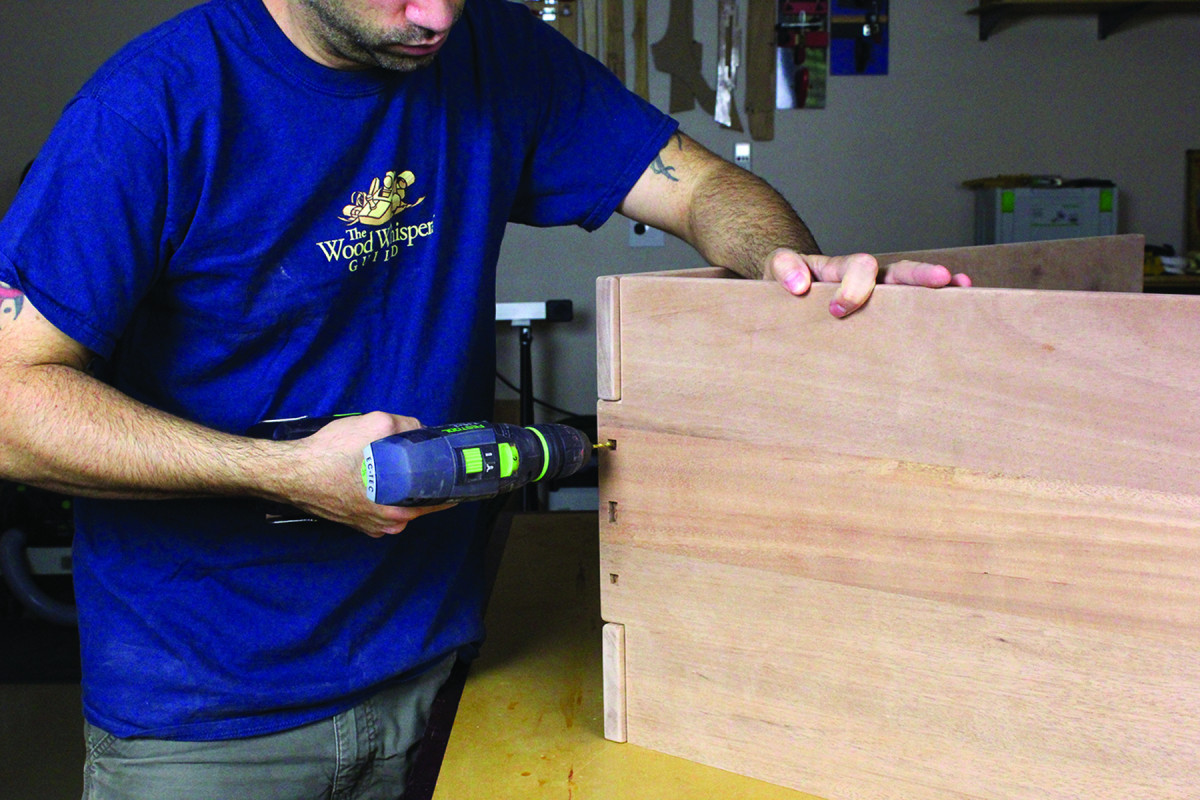
Simple assembly. Screws located under the ebony plugs hold the case together.
With the blanket chest case dry-assembled, measure and cut the 3⁄4“-thick plywood bottom panel to size. The panel can then be glued into the groove on the case front and the rest of the case pieces will come together easily. Using glue on the wide finger joints is optional because the unit is held together with screws. Clamps hold the assembly together as you drive screws. Be sure to check the case for square. Use a diagonal clamp to make any necessary corrections.
Attaching the deck and base to the assembled case is easiest to do with the case upside down. A set of cleats are glued to the case then flushed to the bottom edge. The cleats provide extra support, as well as a safe zone for driving screws. The deck is then centered on the case, and screwed into position through countersunk holes.
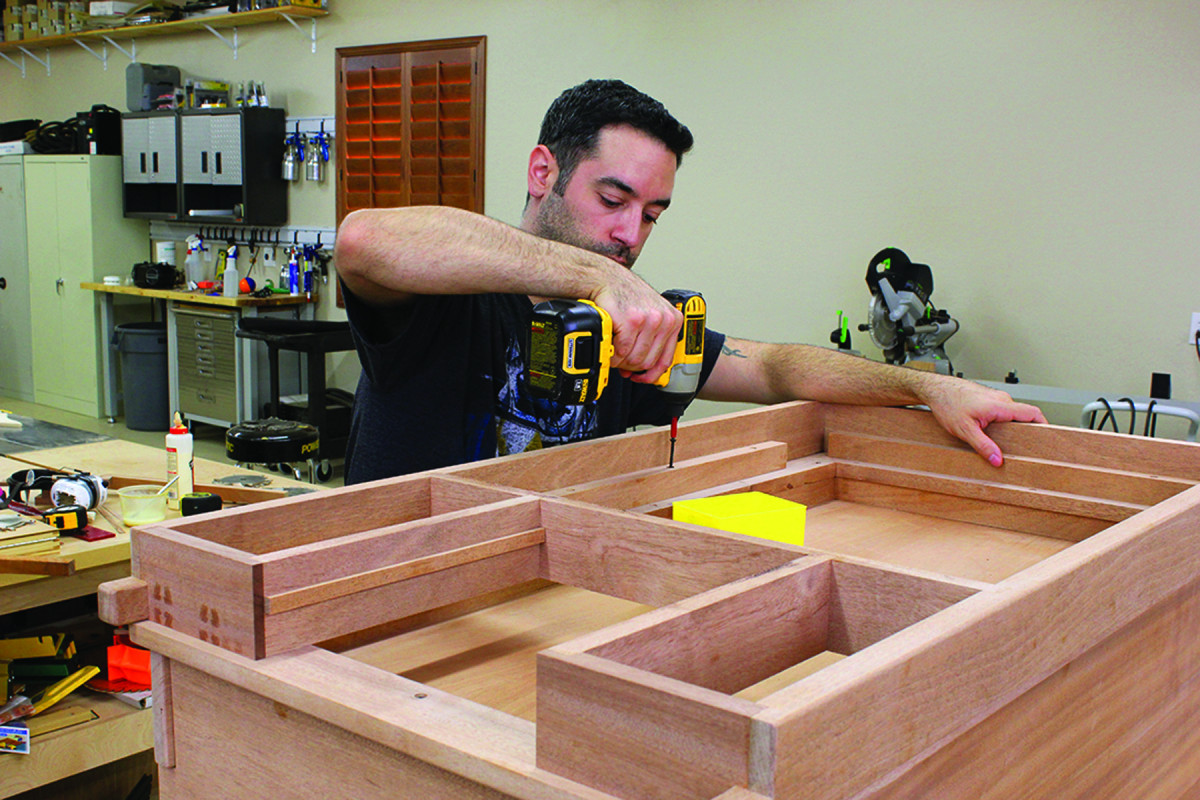
Second time around. Another set of cleats help hold the base firmly to the deck and case.
Before permanently attaching the base to the deck, it’s a good idea to drill, countersink then screw and glue the cleats to the base. Trying to do this work later proves difficult. With the cleats attached, the base is then centered on the deck and attached with #8 x 1 3⁄4” screws.
On Top of it All
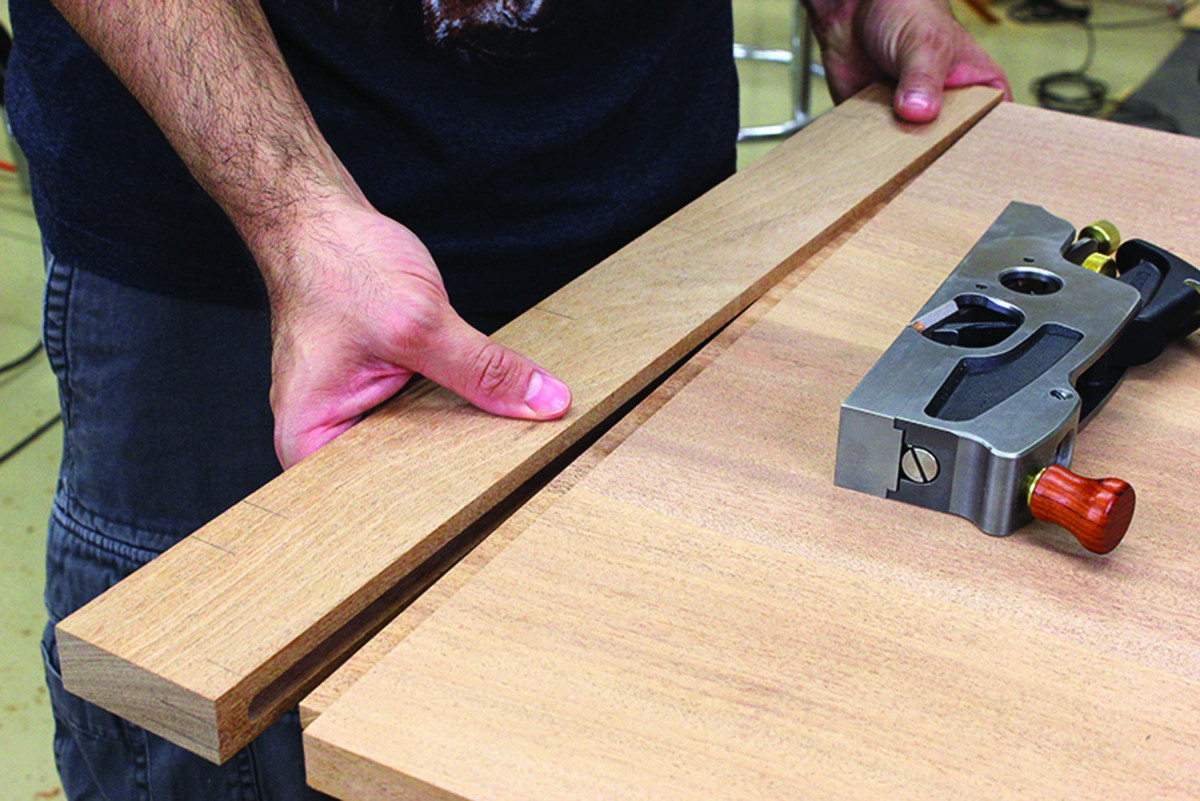
On the end. The groove in the breadboard end fits over the tongue of the top panel. Screws in oversized holes hold the two pieces together.
The blanket chest lid has breadboard ends that stabilize the lid panel and add depth and interest. The breadboards are joined to the panel with a long tongue-and-groove joint. The groove is cut into the breadboards using a drop cut at the router table; make sure to stop prior to the blowing out the ends. The tongue, with its end notched to fit the groove, is routed on the lid panel. Look for a snug fit.
The ends are then screwed into the lid panel through several mortises created for the ebony bars and plugs. The long center bar isn’t functional, but it certainly wins style points. The 3⁄8” x 3⁄8” mortises are made using the 3⁄8” square punch. The long mortises are cut at the router table; be careful to drop and lift the workpiece using layout lines as a guide. The router bit leaves a rounded corner so use a chisel to chop the ends square.
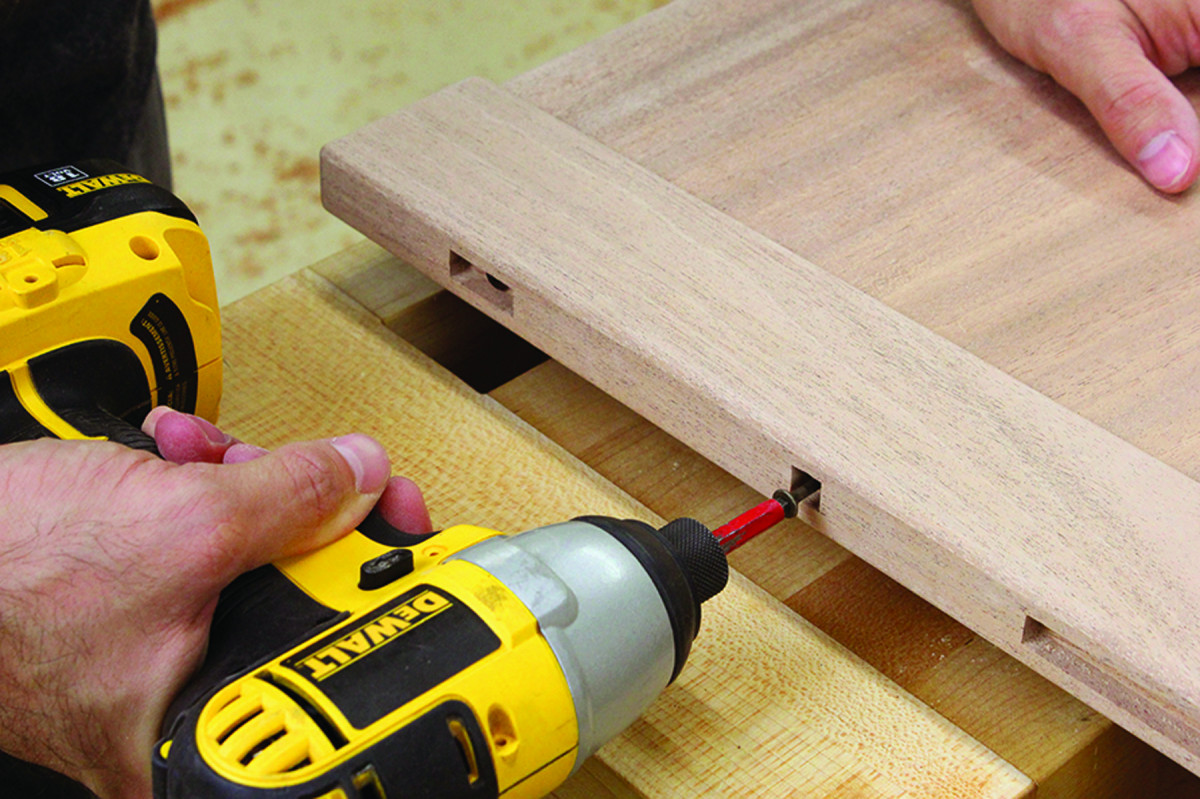
Undercover. Ebony plugs will cover the screw heads after the breadboard ends are attached.
The breadboards are then drilled with a 3⁄16” drill bit. The holes are oversized to allow for wood movement as the lid panel expands and contracts.
Round over the edges of the breadboards and the lid panel before assembly. Attach the breadboard ends to the panel using a small amount of glue at the center, then drive 3″-long screws into the holes to keep the ends tight to the top.
Sculpted Handle
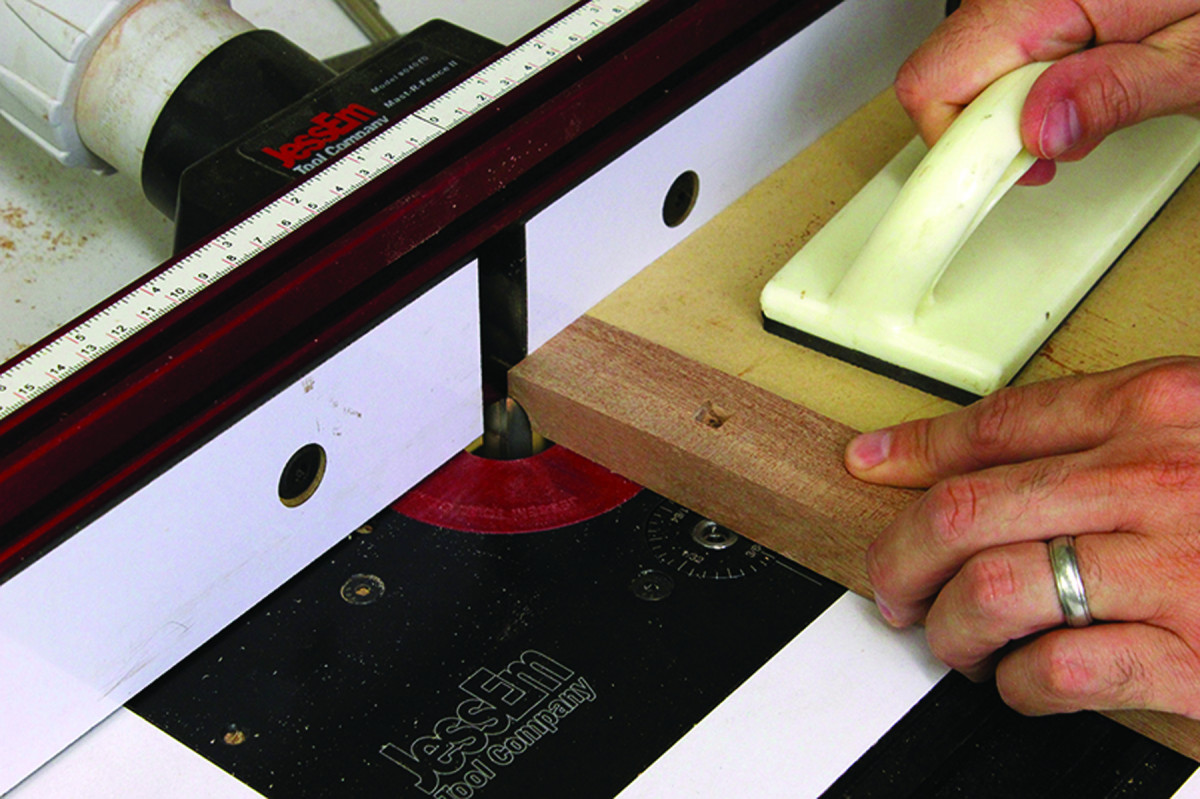
Back up. Scrap wood behind the handle blank makes it easier to control the work as the cove is routed in the end.
The handles may look simple at first glance, but the arch-and-cove profiles present a few challenges. Before shaping the handles, cut the mortises for the ebony plugs.
To shape the arched top of the handle, I use a curved template to help trace the shape of the arch, and to later serve as a router fence. Start with a piece of 3⁄4“-thick sheet stock cut to approximately 10″ x 32” (sized for clamping on a router table).
Mark the center point then measure out 10″ in each direction. Mark the peak of the arch 5⁄16” up on the centerline. Draw the curve from the peak to the 10″ marks using a drawing bow. If you don’t have a drawing bow, draw the same layout 1″ in from the edge and use nails to hold a bending strip in position. Cut the curve with a jigsaw or band saw and smooth the arc using a spindle sander, rasps or a flexible sanding strip.
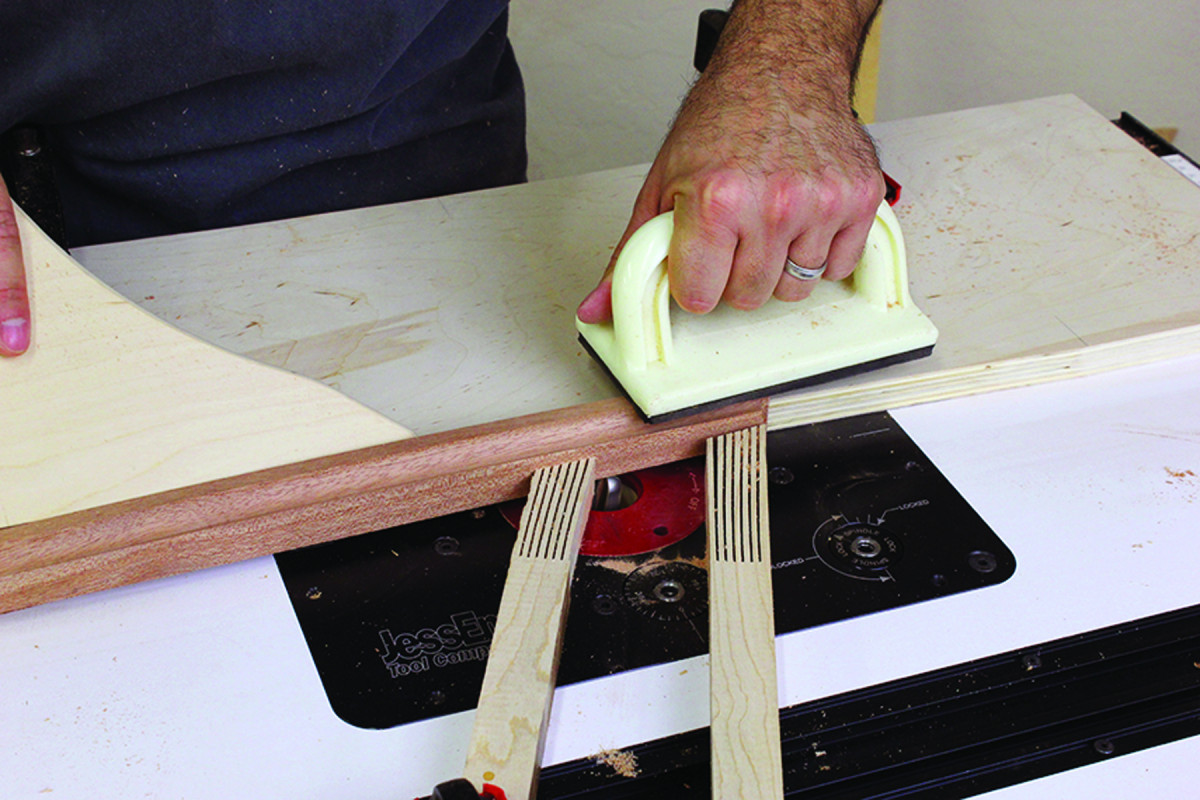
Double duty. The curved template is used as a router fence that supports the arched handle while the cove profile is routed.
With the curve established, transfer the arc to the top of each handle. Align the center of the curve with the center of the handle stock and each end with lines drawn 3⁄16” down, leaving 11⁄16“. Trim to your lines. I use a stationary belt sander to remove the stock to create the arch, but spokeshaves and rasps are another option.
At the router table, I use a 5⁄8” round-nose or core-box router bit to make the cove that goes around the perimeter of the handle. I start with the ends, using a backer board for additional support.
The long sides are routed using the curved template as a fence. Note that the workpiece is pushed from left to right (instead of right to left like you normally do) because the workpiece is behind the bit. (This process is a little tricky, so exercise caution and make the profile cut with multiple passes.)
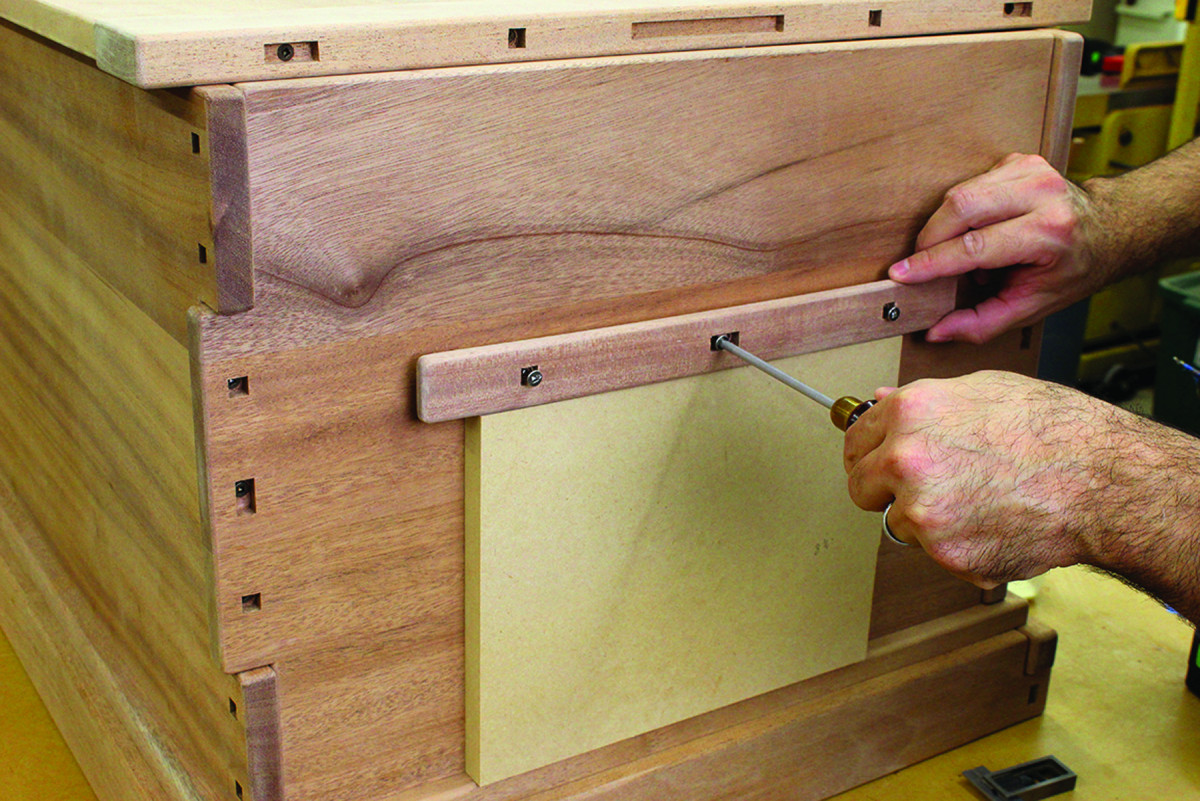
Hold up. A block of MDF supports the handle as it is screwed in place to ensure that the handle is positioned accurately.
Round over the handle and sand it thoroughly to make sure there are no sharp corners, except at the base where the handle attaches to the case.
The handles are glued and screwed to the case sides 83⁄4” up from the deck. I use scrap to support the handle while I drill and drive the 11⁄8“-long screws. Double-check your screw length to ensure they won’t punch through the interior of the case.
A Passel of Plugs
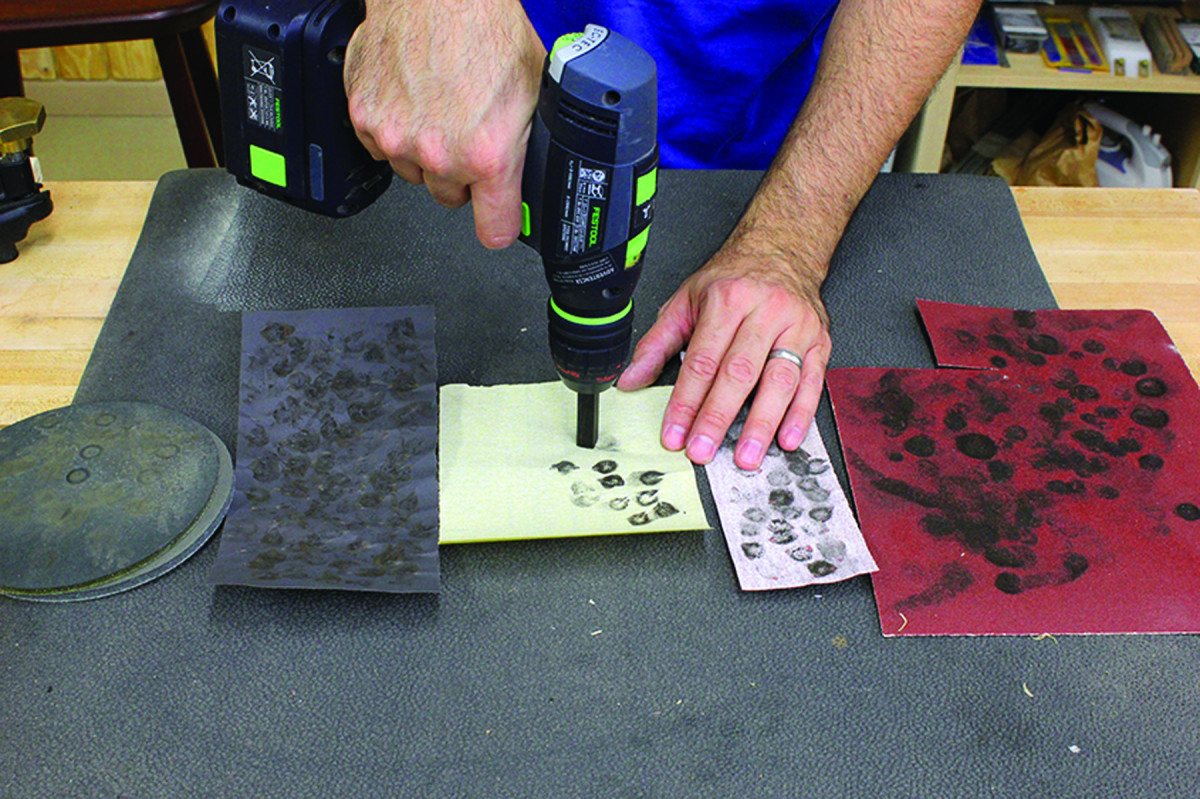
Spin it. A series of sandpaper grits is lined up on a flexible pad, and the drill spins the ebony into each grit.
The blank of ebony is cut into sticks that are 1⁄64” over 3⁄8” square. The blanks are first cut into wide strips, which are then laid flat and cut into sticks. Because cutting thin strips can be dangerous, use a sacrificial push block.
To pillow the ebony plugs, I use a method I learned from William Ng. It involves a drill, a variety of sandpaper grits and a soft foam pad. With a chisel, chamfer the corners of the last inch of each stick. This allows the stick to fit into a standard 3⁄8” drill chuck.
Starting with #80 grit, pulse the drill with the end grain of the stick resting on the sandpaper and let the weight of the drill do the work. The sandpaper can be backed up with anything that has give. Move from one grit to the next until you reach #1,000 grit to bring the surface to a polished shine.
With the pillow created on the end of the stick, a simple jig is used to cut the plug off the end. My jig is made from scrap and holds the stick snug for sawing, guides the saw blade for a nice square cut and ensures each plug is the same length.
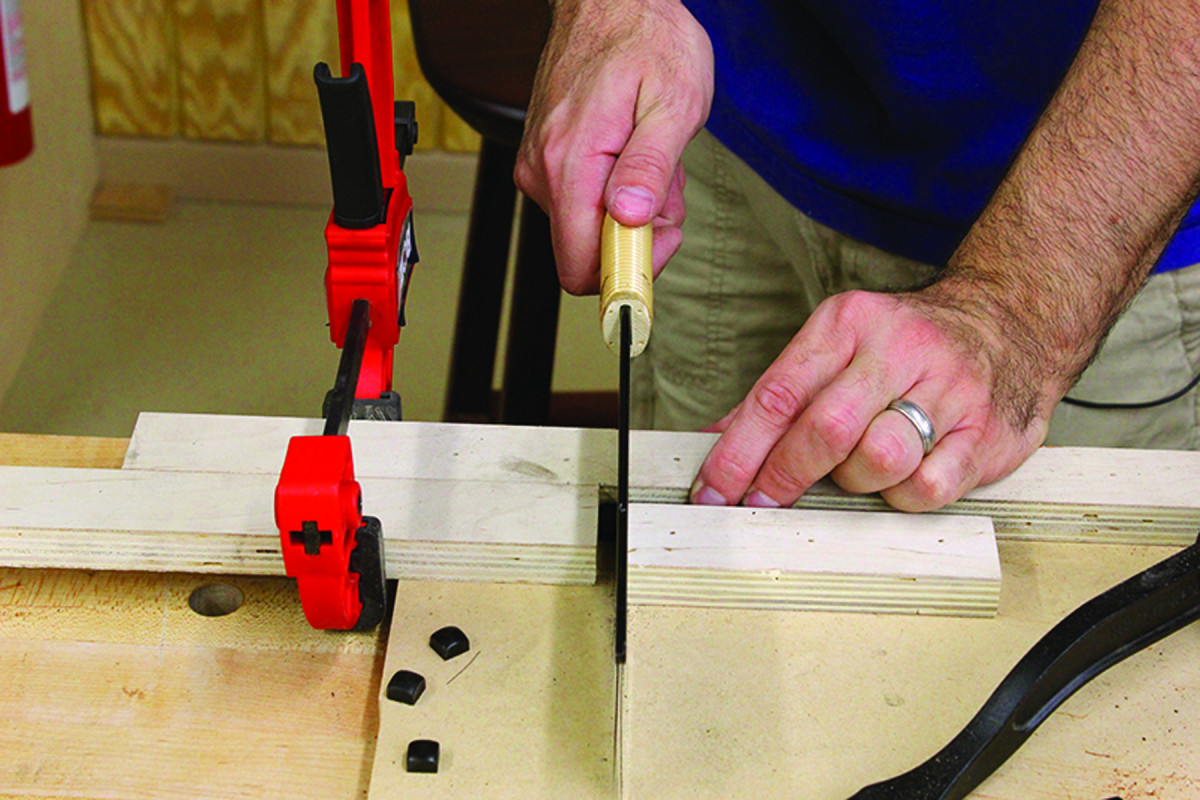
All the same. This jig is used to cut each plug to an identical length.
The remaining ebony sticks can be further trimmed at the table saw for use as bars, ripping them down to about 1⁄4” in one dimension and leaving the other dimension at 1⁄64” over 3⁄8“. To create the pillowed effect on the bars, I use a 1⁄2“-radius roundover bit and lower the bit so that it just catches the vertical portion of the cutter. With the help of another jig (shown above), you can safely take two passes to create the pillowed effect.
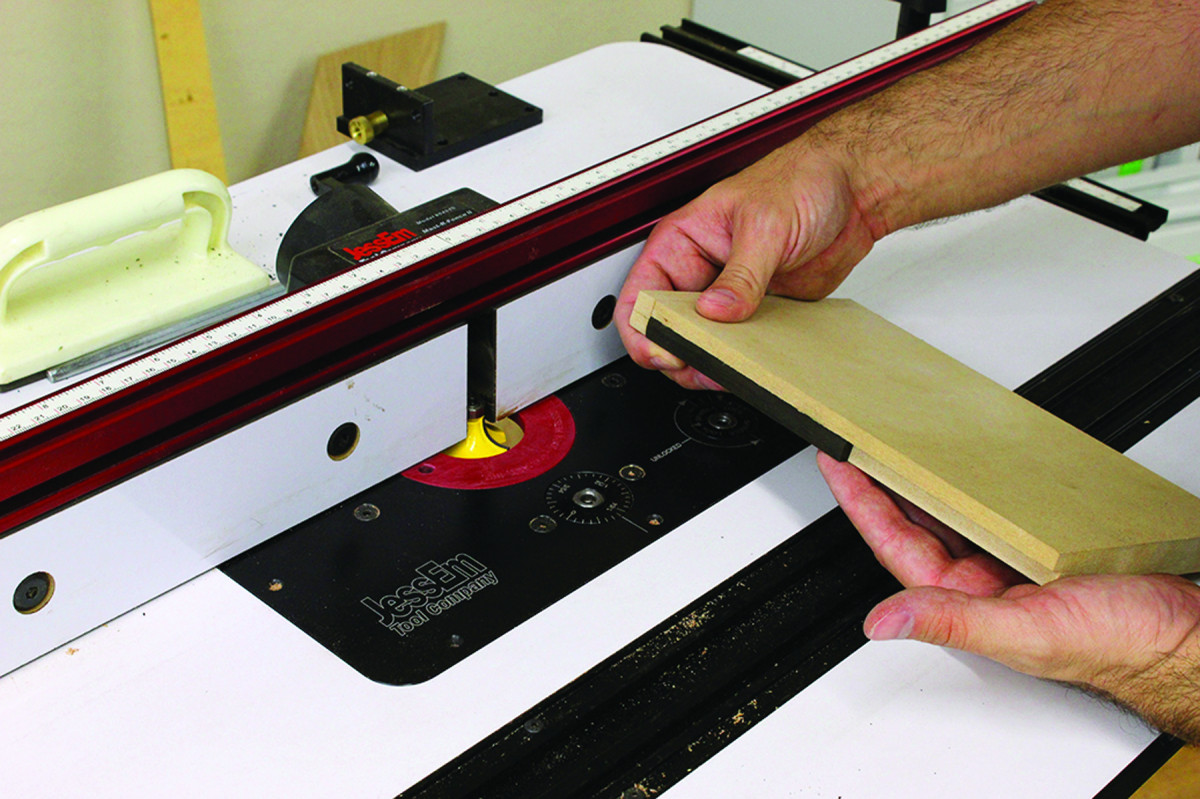
Hands back. This simple made-from-scrap jig holds the ebony bar so the profile can be safely routed.
The square plugs are tapered on each side so they wedge into the mortises. This is done with a few strokes of a chisel. For the bars, I use sandpaper to create the taper. To install the plugs and bars, use glue and a plastic-headed hammer. The key is to use light but firm taps that leave the plugs proud of the surface. Be careful not to push the plug in too far because it is very difficult to remove without doing damage.
Dye & Lacquer
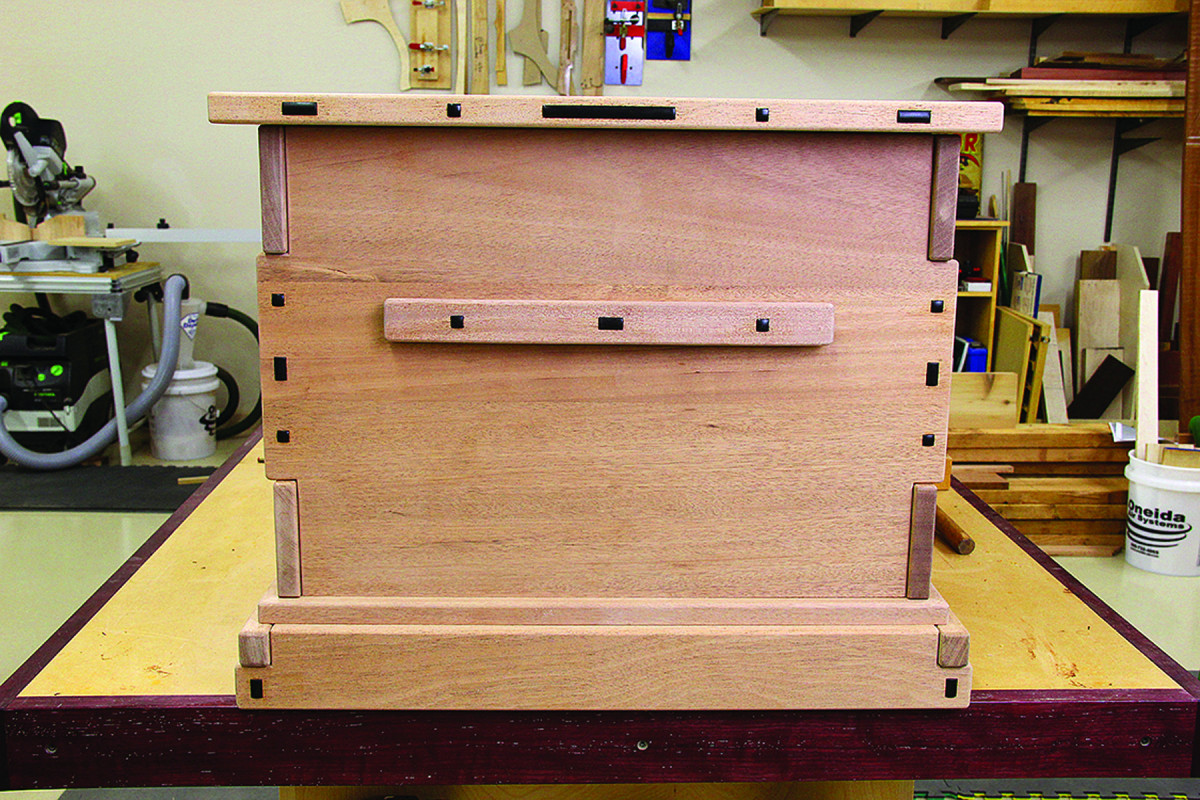
A pattern emerges. The dark plugs and bars add a decorative element and hide the screws.
When it comes to Greene & Greene projects, it’s hard to argue with the beauty and elegance provided by the right stain. The dye mixture I use is a 1:2 ratio of General Finishes Medium Brown to Orange. The dye is water-based, so I raise the grain with water and sand before applying the dye. The dye is sprayed coating the surface liberally, then I wipe away any standing liquid with a pre-moistened terry cloth sponge.
For a topcoat I used three coats of CAB acrylic lacquer with light sanding between each coat. After a week of cure time, I rubbed the surface with a #2,000-grit abrasive pad. The high grit doesn’t change the sheen of the finish, but it produces a glass-smooth surface.
Before calling this project complete, there are a few loose ends to tie up, including the drawer magnets, the hinges and corner blocks (to raise the chest off the floor).
The hidden drawer is held closed with rare-earth magnets. I used them on the inside of the drawer face, but outside the drawer box. The 1⁄2“-diameter magnets are epoxied in shallow holes.
You can use traditional butt hinges to attach the lid to the case, but I prefer to use torsion hinges. They install in seconds with no mortising and allow the lid to stay open without the need for additional safety mechanisms.
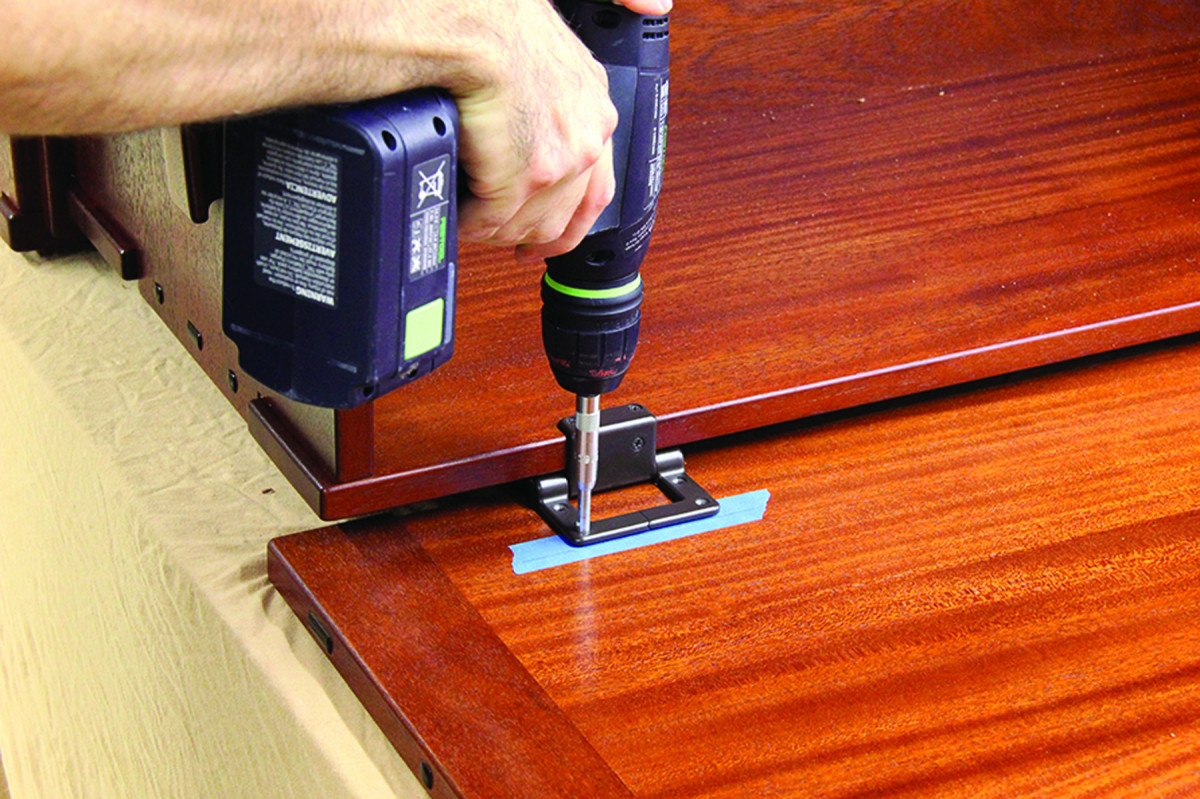
Swing & hold. Torsion hinges serve to hold the lid open without any additional support.
Four corner blocks are cut from scrap wood and attached to the inside corners of the base, with the blocks sitting under the deck. These keep the chest off the ground while allowing the drawer to operate properly. If you have carpet, you may consider longer blocks that raise the case even higher.
This blanket chest serves as a great starting point for anyone looking to dive into the world of Greene & Greene, and it only scratches the surface of what the style has to offer. Even if you’re not a fan of Greene & Greene, you probably have an appreciation for the care and attention that goes into creating the eye-catching details.
Video: Watch an interview with the author.
Plan: A SketchUp model of this project is available free online.
Here are some supplies and tools we find essential in our everyday work around the shop. We may receive a commission from sales referred by our links; however, we have carefully selected these products for their usefulness and quality.



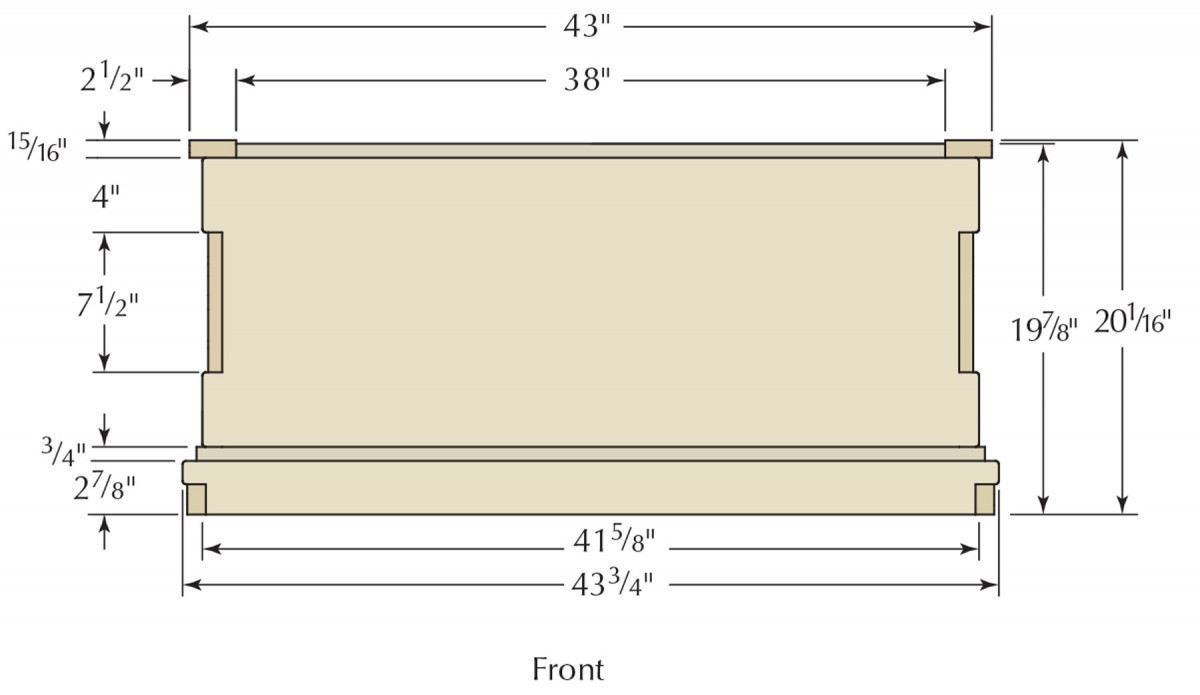
 I’ve Got a Secret (Drawer)
I’ve Got a Secret (Drawer)




